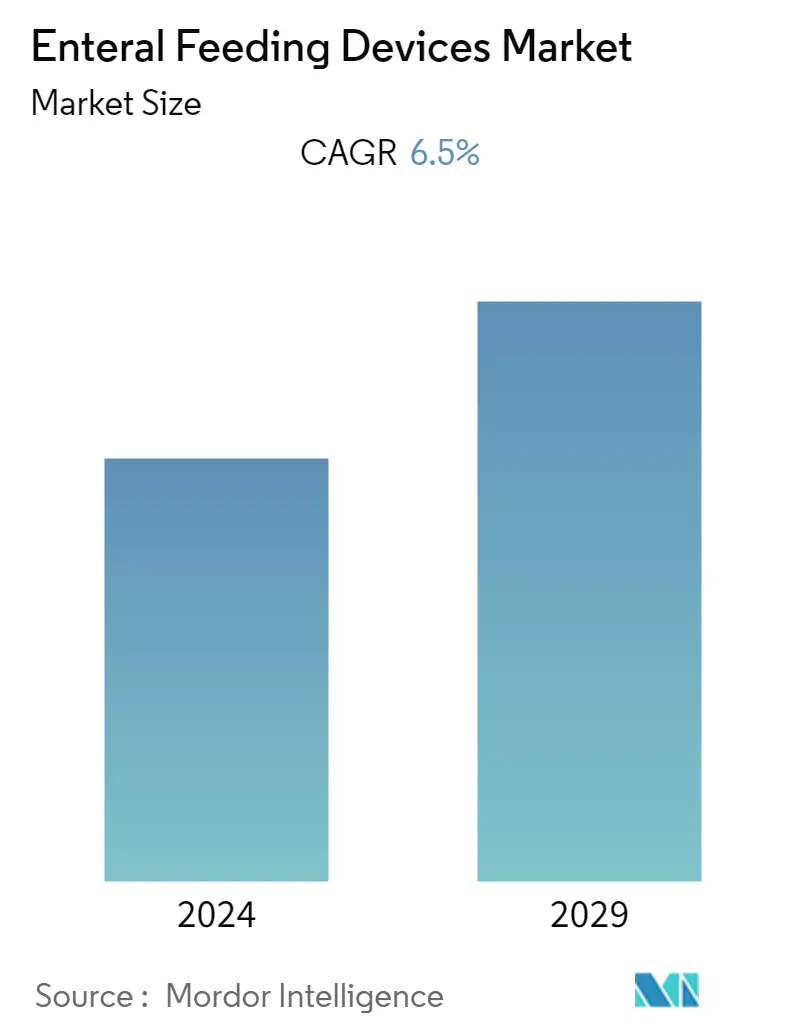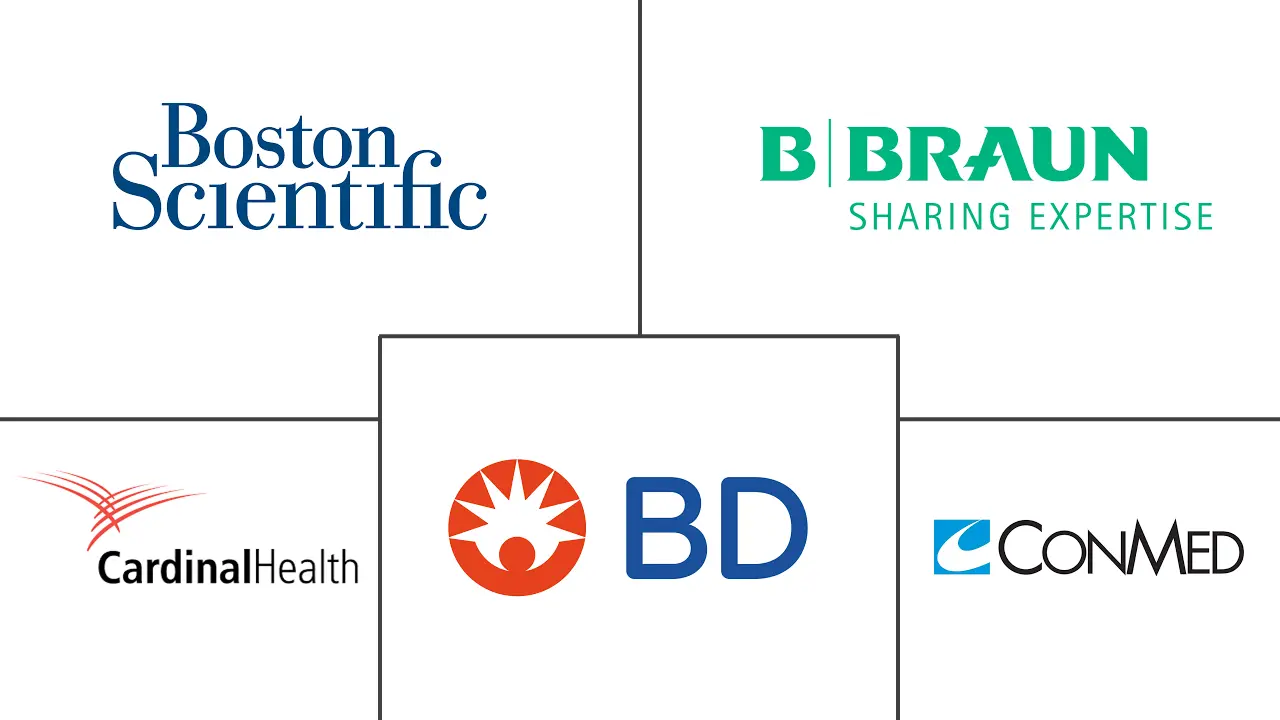Market Size of Enteral Feeding Devices Industry

| Study Period | 2019 - 2029 |
| Base Year For Estimation | 2023 |
| CAGR | 6.50 % |
| Fastest Growing Market | Asia-Pacific |
| Largest Market | North America |
| Market Concentration | Low |
Major Players
*Disclaimer: Major Players sorted in no particular order |
Enteral Feeding Devices Market Analysis
The enteral feeding devices market registered a CAGR of 6.50% over the forecast period.
The COVID-19 pandemic significantly impacted the enteral feeding devices market. Due to the disturbance of the normal intestinal mucosa, patients with COVID-19 who were extremely unwell had reduced nutrient absorption. For instance, according to a research article published by the National Library of Medicine in March 2022, patients had considerable levels of inflammation, stress, and catabolism, as well as a marked rise in their need for protein and calories. Immediate enteral nutrition support and the provision of sufficient nutrients were essential to prevent malnutrition in these patients. According to guidelines by the European Society for Clinical Nutrition and Metabolism (ESPEN) on nutrition in the ICU, gastric enteral nutrition was advised for severe COVID-19 patients. It should preferably be performed using a pump with a flow regulator within 48 hours of admission to the ICU. Hence, the COVID-19 pandemic increased the need for enteral feeding devices, especially for those in intensive care units. Hence, the market is expected to have stable growth over the forecast period.
The factors responsible for the market's growth include the growing geriatric population and age-related chronic diseases, the increasing number of premature births, and the growing demand for enteral feeding in home care settings. For instance, according to the Center for Disease Control (CDC) update on Preterm birth, in November 2022, preterm birth affected about 1 of every 10 infants born in the United States in 2021. The preterm birth rate rose 4% in 2021. The rate of preterm birth among African-American women (14.8%) was about 50% higher than the rate of preterm birth among white or Hispanic women (9.5% and 10.2% respectively) in 2021. Since preterm birth is frequently associated with the progressive development of malnutrition, these statistics indicate that the demand for enteral feeding devices is anticipated to increase over the coming years.
Additionally, various initiatives taken by the key market players, such as product launches, mergers, acquisitions, and partnerships, are expected to boost the market's growth during the forecast period. For instance, in September 2021, Vonco Products LLC reported that the patented EnteraLoc Flow direct-connect enteral nutritional delivery system was granted 510(k) clearance by the U.S. Food and Drug Administration (FDA). Such product clearance is expected to significantly impact the market, thereby driving the market's growth.
The above-mentioned factors, such as the growing geriatric population and age-related chronic diseases, the increasing number of premature births, and the growing demand for enteral feeding in home care settings, are expected to drive the enteral feeding device market growth across the world. However, complications associated with enteral feeding tubes and healthcare reimbursement issues are the major factors restraining the market's growth.
Enteral Feeding Devices Industry Segmentation
As per the scope of the report, enteral feeding refers to the delivery of a nutritionally complete feed containing protein, carbohydrates, fat, water, minerals, and vitamins directly into the stomach, duodenum, or jejunum through devices such as tubes and pumps. It is used for people who have a functional gastrointestinal tract but are unable to consume foods orally to meet their nutrient requirements. The enteral feeding devices market is segmented by product type (enteral feeding pumps, enteral feeding tubes, and other product types), age group (adults and pediatrics), end user (hospitals, ambulatory care services, and other end users), application (oncology, neurology, critical care, diabetes, gastroenterology, and other applications), and geography (North America, Europe, Asia-Pacific, Middle East and Africa, and South America). The report also covers the estimated market sizes and trends for 17 countries across major regions globally. The report offers the value (in USD) for the above segments.
| By Product Type | |
| Enteral Feeding Pumps | |
| Enteral Feeding Tubes | |
| Other Product Types |
| By Age Group | |
| Adults | |
| Pediatrics |
| By End User | |
| Hospitals | |
| Ambulatory Care Services | |
| Other End Users |
| By Application | |
| Oncology | |
| Neurology | |
| Critical Care | |
| Diabetes | |
| Gastroenterology | |
| Other Applications |
| Geography | ||||||||
| ||||||||
| ||||||||
| ||||||||
| ||||||||
|
Enteral Feeding Devices Market Size Summary
The enteral feeding devices market is poised for stable growth, driven by several key factors. The COVID-19 pandemic significantly heightened the demand for these devices, particularly in intensive care units, due to the increased nutritional needs of severely ill patients. The growing geriatric population, rising prevalence of age-related chronic diseases, and the increasing number of premature births further contribute to the market's expansion. Additionally, the demand for enteral feeding in home care settings is on the rise, reflecting a broader trend towards at-home medical care. Market players are actively engaging in strategic initiatives such as product launches and partnerships, which are expected to bolster market growth. However, challenges such as complications associated with enteral feeding tubes and healthcare reimbursement issues may impede progress.
The market is characterized by a fragmented landscape with numerous global and regional players, including prominent companies like B. Braun Melsungen AG, Boston Scientific Corporation, and Cardinal Health. The North American region is anticipated to hold a significant market share, driven by the increasing burden of chronic diseases and surgical procedures. The diabetes segment, in particular, is expected to witness substantial growth due to the rising prevalence of diabetes and the need for specialized nutritional management. Innovations such as the EnteraLoc Flow direct-connect system and the addition of Nasogastric Tubes to product portfolios are indicative of the ongoing advancements in the field. These developments, coupled with strategic acquisitions and expansions, are likely to propel the market forward over the forecast period.
Enteral Feeding Devices Market Size - Table of Contents
-
1. MARKET DYNAMICS
-
1.1 Market Overview
-
1.2 Market Drivers
-
1.2.1 Growing Geriatric Population and Age Related Chronic Diseases
-
1.2.2 Increasing Number of Premature Births
-
1.2.3 Growing Demand for Enteral Feeding in Home Care Settings
-
-
1.3 Market Restraints
-
1.3.1 Complications Associated with Enteral Feeding Tubes
-
1.3.2 Healthcare Reimbursement Issues
-
-
1.4 Porter's Five Forces Analysis
-
1.4.1 Threat of New Entrants
-
1.4.2 Bargaining Power of Buyers/Consumers
-
1.4.3 Bargaining Power of Suppliers
-
1.4.4 Threat of Substitute Products
-
1.4.5 Intensity of Competitive Rivalry
-
-
-
2. MARKET SEGMENTATION (Market Size by Value- USD million)
-
2.1 By Product Type
-
2.1.1 Enteral Feeding Pumps
-
2.1.2 Enteral Feeding Tubes
-
2.1.3 Other Product Types
-
-
2.2 By Age Group
-
2.2.1 Adults
-
2.2.2 Pediatrics
-
-
2.3 By End User
-
2.3.1 Hospitals
-
2.3.2 Ambulatory Care Services
-
2.3.3 Other End Users
-
-
2.4 By Application
-
2.4.1 Oncology
-
2.4.2 Neurology
-
2.4.3 Critical Care
-
2.4.4 Diabetes
-
2.4.5 Gastroenterology
-
2.4.6 Other Applications
-
-
2.5 Geography
-
2.5.1 North America
-
2.5.1.1 United States
-
2.5.1.2 Canada
-
2.5.1.3 Mexico
-
-
2.5.2 Europe
-
2.5.2.1 Germany
-
2.5.2.2 United Kingdom
-
2.5.2.3 France
-
2.5.2.4 Italy
-
2.5.2.5 Spain
-
2.5.2.6 Rest of Europe
-
-
2.5.3 Asia-Pacific
-
2.5.3.1 China
-
2.5.3.2 Japan
-
2.5.3.3 India
-
2.5.3.4 Australia
-
2.5.3.5 South Korea
-
2.5.3.6 Rest of Asia-Pacific
-
-
2.5.4 Middle East and Africa
-
2.5.4.1 GCC
-
2.5.4.2 South Africa
-
2.5.4.3 Rest of Middle East and Africa
-
-
2.5.5 South America
-
2.5.5.1 Brazil
-
2.5.5.2 Argentina
-
2.5.5.3 Rest of South America
-
-
-
Enteral Feeding Devices Market Size FAQs
What is the current Enteral Feeding Devices Market size?
The Enteral Feeding Devices Market is projected to register a CAGR of 6.5% during the forecast period (2024-2029)
Who are the key players in Enteral Feeding Devices Market?
B. Braun Melsungen AG, Boston Scientific Corporation, Conmed Corporation, Cardinal Health, Inc. and Becton, Dickinson and Company are the major companies operating in the Enteral Feeding Devices Market.

